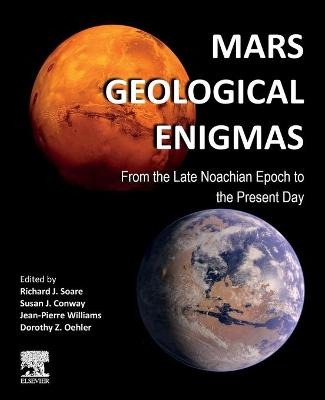
Mars Geological Enigmas
Elsevier Science Publishing Co Inc (Verlag)
978-0-12-820245-6 (ISBN)
Richard Soare is a physical geographer specializing in periglacial (cold-climate, non-glacial landscapes). Through the last twenty years he has spent considerable time in the Canadian arctic (physically) and off-planet (intellectually), attempting to identify landscapes on Mars present or past possibly molded by the freeze-thaw cycling of water. His work spans the red planet geographically, ranging from the plains of Utopia Planitia in the northern hemisphere and the Moreux impact-crater at the Mars dichotomy through to the Argyre impact-crater in the southern hemisphere. Recently, he lead-edited “Mars Geological Enigmas: from the late Noachian Epoch to the present day and a special issue of Icarus: “Current and Recent Landscape Evolution on Mars. Susan Conway is a CNRS research scientist in Nantes, France, having graduated with a PhD in planetary science from the Open University (United Kingdom) in 2010. She is chair of the International Association for Geomorphologists (IAG) Planetary Geomorphology Working Group, and has run the Planetary Geomorphology session at the European Geoscience Union since 2011. She is lead editor for a collection of papers on Martian gullies and their Earth analogues, based on the workshop she organized at the Geological Society of London in June 2016 and is co-editor on a collection of papers entitled "Frontiers in Geomorphometry". She is a team member on the High Resolution Imaging Science Experiment (HiRISE) instrument on NASA's Mars Reconnaissance Orbiter and Guest Investigator on the ESA Trace Gas Orbiter mission to Mars, specifically focused on the CaSSIS camera and NOMAD/ACS spectrometer instruments. She is on the author list of 35 peer-reviewed papers concerning the geomorphology of Earth, Mars, Mercury, the Moon and the asteroid Vesta. Her work is concentrated around glacial, periglacial and fluvial landforms on Mars, encompassing field, remote sensing and laboratory simulation data, with a specialty in analysis of 3D terrain data. Jean-Pierre Williams is a planetary scientist at the University of California in Los Angeles (UCLA). He received his PhD in Geophysics and Space Physics from UCLA and was a research scientist at the California Institute of Technology (Caltech) for five years before accepting a position at UCLA. His work focuses on the geology and physics of the inner planets, and he has authored and co-authored over sixty peer-reviewed publications on Mars, Mercury, and the Earth’s Moon. He is currently the Deputy Principal Investigator of the Diviner Lunar Radiometer Experiment on the Lunar Reconnaissance Orbiter, a member of the ShadowCam instrument team on the Korean Pathfinder Lunar Orbiter (Danuri) mission, which will image the permanently shadowed regions near the poles of the Moon, and a Co-Investigator of the Lunar Vulkan Imaging and Spectroscopy Explorer (Lunar-VISE), a lander and rover that will explore the summit of a volcanic dome on the Moon. Dorothy Oehler is a planetary geologist and Precambrian paleontologist seeking ways to identify biosignatures of potential, past life on Mars and predict optimal locations in which to search for biosignatures. She obtained her Ph.D. from the University of California at Los Angeles (UCLA), then spent several years in petroleum research focusing on methane in the subsurface of the Earth. She now applies that background to investigations of methane on Mars. Dr. Oehler spent the years from 2003 to 2016 at Johnson Space Center and was a member of the 1st Mars Science Laboratory (Curiosity Rover) Science Team. Currently, she continues her work on methane on Mars, earliest life on Earth, and potential biosignatures on Mars. In 2012, Dr. Oehler was named Distinguished Alumna from the Department of Earth, Planetary, and Space Sciences at UCLA.
1. Current enigmas identified by the Curiosity rover at the Gale crater
Node I What sourced the enormous flows and volumes that formed the outflow channels and highland-margin contacts of ancient Mars? 2. The fluvial interpretation of outflow channels on Mars: landforms, processes and paleoenvironmental implications 3. Was there an early Mars ocean? 4. Dry megafloods on Mars: formation of the outflow channels by voluminous effusions of low viscosity lava
Node II Can impact craters be used to derive reliable surface ages on Mars? 5. Challenges in crater chronology arising from the Jezero impact crater 6. The role of secondary craters on Martian crater chronology
Node III The perplexing story of methane on Mars 7. Methane on Mars: subsurface sourcing and conflicting atmospheric measurements 8. A review of the meteor shower hypothesis for methane on Mars
Node IV Does water flow on Martian slopes? 9. The possible role of water in recent surface-processes on Mars 10. Dry formation of recent Martian slope-features
Node V Earth analogues for Mars - a plethora of choice! 11. The McMurdo Dry Valleys of Antarctica: a geological, environmental and ecological analog to the Martian surfac 12. The Atacama Desert: a window into late Mars surface habitability 13. Ancient life in diverse habitats from the Pilbara Craton and Mount Bruce Supergroup, western Australia: analogues for early Mars?
Node VI The freeze-thaw cycling of water at/near the Martian surface: present, past and possible? 14. Pingo-like mounds and possible periglaciation/glaciation at/adjacent to the Moreux impact crater, Mars 15. Thermokarst-like depressions on Mars: age constraints on ice degradation in Utopia Planitia
Node VII Hemispheres together: towards understanding the Mars dichotomy 16. Forging the Mars crustal-dichotomy: the giant impact hypothesis 17. Endogenic origin of the Martian hemispheric dichotomy? James Roberts
| Erscheinungsdatum | 08.06.2021 |
|---|---|
| Sprache | englisch |
| Maße | 191 x 235 mm |
| Gewicht | 1130 g |
| Themenwelt | Naturwissenschaften ► Geowissenschaften ► Geologie |
| Naturwissenschaften ► Physik / Astronomie ► Astronomie / Astrophysik | |
| Technik ► Luft- / Raumfahrttechnik | |
| ISBN-10 | 0-12-820245-9 / 0128202459 |
| ISBN-13 | 978-0-12-820245-6 / 9780128202456 |
| Zustand | Neuware |
| Haben Sie eine Frage zum Produkt? |
aus dem Bereich


